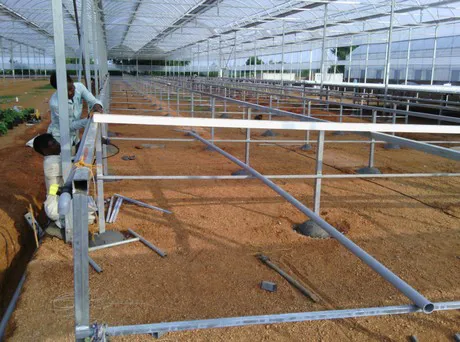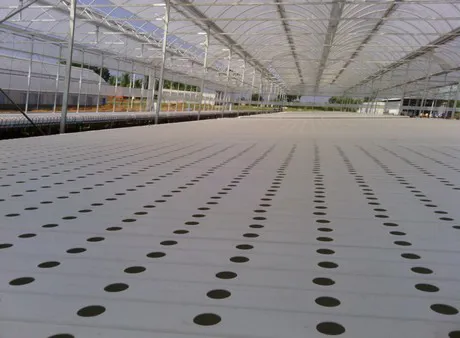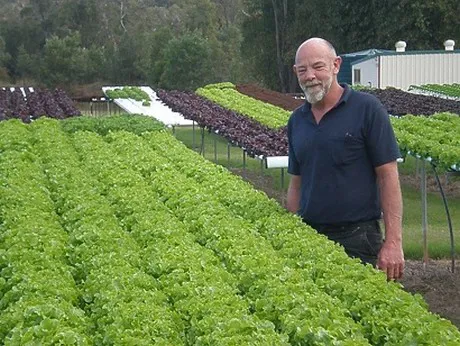Like in many places in the world, the demand for fresh and locally produced greenhouse vegetables is also on the rise in India. In order to meet this demand, the group contacted Brian Ellis Consulting to find a way to grow premium produce year round.
The project is designed to produce crops such as leafy greens, flowers, vegetables, fruits, ginger and others in the extreme climate of Hyderabad. "Growers over here are dealing with extreme climatic conditions at times," explained Brian Ellis of BEC. "In summer 45 degrees Celsius is the norm, although it can often reach 50 degrees Celsius. Then comes the monsoon season when it (supposedly) cools off, but is still subject to temperatures of + high 30's, heavy rainfall and high humidity. It is also a very windy place at times. When we then consider the record extremes of the past year which include unseasonal floods and a severe heat wave that took many lives, it is definitely one of the more challenging climates on the planet for year-round production of premium produce."

Construction work at the project
Five greenhouses have been constructed at the site, three of them are retractable roof systems and two others are butterfly structures. Consultant Brian Ellis was involved in the project right from concept through to commissioning, with contribution in all facets. "This included earthworks design, site layout, greenhouse specifications, growing system designs, water treatment, building designs, ancillary infrastructure, equipment installations, training and ongoing consultancy."
MMGS
The growing systems installed at the project include continuous flow NFT, pulse feed NFT, flood & drain, media based pot systems, media based bed systems and media based hanging gutter systems.
A MMGS (Manual Moving Gulley System designed by BEC) will be used to optimise growing space within the greenhouse. "When compared with a static table system, the MMGS provides more than double the plant numbers per m2 of available floor space. This is achieved by greatly reducing the number of walkways within the greenhouse and closing up the gully spacings for immature plants."

The hydroponic gutter system set up
Drawing on extensive experience as a commercial hydroponic grower in Australia and many years as a hydroponic consultant, Brian explained that he designed the various growing systems and structures specially to cope with the high summer temperatures in Hyderabad. The strong but flexible retractable roof systems and greenhouses protect the crops against extreme weather circumstances and can adapt to the climate, while the irrigation systems are designed to work in high temperatures as well.
Temperature of irrigation water
"Too often we see system designs and practices transplanted from milder regions to locations with a more severe climate," Brian explained. "This usually equates to less than desired results, which unfortunately leads to disappointment, and some to wrongly believe that leafy greens are only a cool climate plant. This is simply not true, however system design is only part of the equation, it is also important to have a good grower or consultant who has solid experience with growing in high temperatures and high humidity."
For example: in order to optimize the system to work in high temperatures, BEC designed a special irrigation buffer tank set up, which results in a constant cool temperature of the nutrient solutions; with this set up the solution temperature remain constant between 21 and 23 degrees Celsius, even at day times of 41 degrees Celsius. "If solution temperatures are allowed to reach high 20’s the plants become stressed and subject to pathogen attack. On the other hand if the solution temperature cools into the teens, the plant growth will slow down until it gets to a point where they almost become dormant if the root zone temperature were to get as low as 10-12 Celsius."
The leafy greens greenhouse for this project only has passive cooling with a retractable roof and roll up sides for venting. Brian points out that this was deliberate as leafy greens can handle and even thrive in very hot ambient temperatures providing other perimeters including the root zone are correctly managed. "The retractable roof and roll up sides will be kept open except during rain or very windy conditions. Exposing the plants to nature at other times allows for a stronger, healthier and more vibrant plant with deeper colour and extended shelf life. The key is to maintain a healthy root zone, more so than controlling the ambient temperature."
"Another very important element is seedlings," said Brian when explaining that these must be grown and acclimatised to the environment into which they are going to be transplanted. "If raising your seedlings in an air-conditioned room or with low light levels prior to transplanting them into a harsher environment, you can expect them to struggle. They must be acclimatised before transplanting."
Trinog
Three of the greenhouses are retractable roof structures, with the forth being a single structure divided into two individual greenhouses by an internal wall. These feature independent controls for the butterfly roof, pad & fan cooling, retractable aluminium screens and high pressure fog systems. BEC was working with Trinog on this project. Since then they have taken on authorised distributorship for Trinog products.
Autogrow Systems NZ
Futhermore, Autogrow Systems from New Zealand was involved in the project. They supplied their Multigrow greenhouse and fertigation controller. It includes a full weather station, environment sensors in all greenhouses, data logging and remote access for the grower. The Multigrow controls all aspects of venting, shading, fogging, cooling, fertigation and dosing, as well as most irrigation operations. It also backs up its entire history to Autogrow’s secure server ensuring that in the event of an issue in the field no history is lost. "The Multigrow provides remote access in real time so that the client can monitor greenhouse performance from anywhere in the world, and it allows representatives from BEC to provide remote support and diagnose any issues, as well as deploy any updates or changes the client requires."

Brian Ellis
For more information:
Brian Ellis Consulting
Skype brian.r.ellis
info@brianellisconsulting.com
www.brianellisconsulting.com
